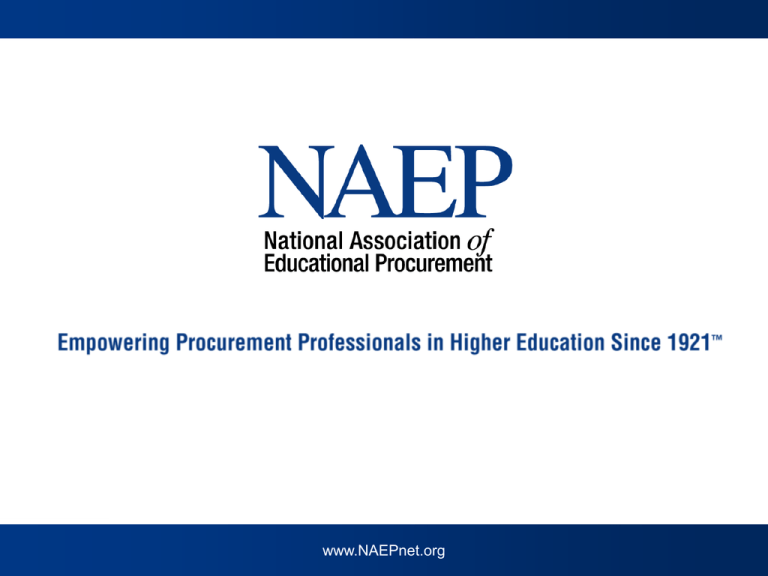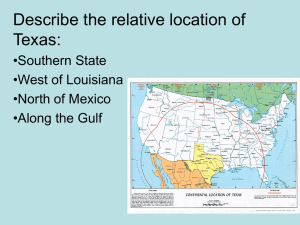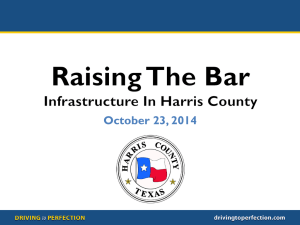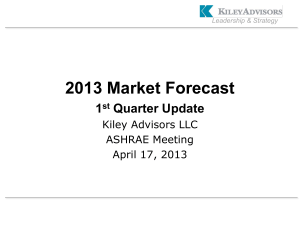4_Costing methods by Tom Vaughn
advertisement

Facilities Institute July 9 - 12, 2012 www.NAEPnet.org Houston, Texas A Primer on Standard Costing Methods for Construction Projects Presented by Tom Vaughn, CEO Facilities Institute July 9 - 12, 2012 Houston, Texas Agenda • Defining Terms • Construction Cost Components • Four Common Contract Types ‒ ‒ ‒ ‒ Definition/What’s Included Delivery Methods Associated with Each Pros/Cons Best/Least suited projects • Market Forecasting Facilities Institute July 9 - 12, 2012 Houston, Texas Defining Terms Management Options Selection Criteria Delivery Methods Contract Types Facilities Institute July 9 - 12, 2012 Houston, Texas Defining Terms • Delivery Methods 1. 2. 3. 4. 5. Traditional (Design-Bid-Build) Competitive Sealed Proposal (CSP) Construction Manager at Risk (CM at R) Design/Build Job Order Contract (JOC) • Selection Criteria 1. Low bid 2. Best value 3. Qualification based Price Only • Contract Types 1. 2. 3. 4. Lump Sum Cost + Fee Cost + Fee with GMP JOC (unit price) Facilities Institute July 9 - 12, 2012 Houston, Texas Qualifications Only Construction Cost Components • Four Basic Components ‒ ‒ ‒ ‒ Preconstruction Phase Fee Construction Fee General Conditions Contingency • Type of Contract dictates which of these components are included Facilities Institute July 9 - 12, 2012 Houston, Texas Preconstruction Phase Fee • • • • • • • • Preliminary Budget & Schedule Constructability Reviews Ongoing Scheduling – Design & Construction Ongoing Budget/Cost Consultation Coordination of Construction Documents Bid Package Strategy Obtaining Bids Compensation: Lump Sum/Cost Plus or GMP Facilities Institute July 9 - 12, 2012 Houston, Texas Construction Fee • Profit • Home Office Overhead ‒ ‒ ‒ ‒ Estimating Accounting Human Resources Legal ‒ ‒ ‒ ‒ Facilities Institute July 9 - 12, 2012 Houston, Texas Corporate Safety Executives Interest Cost Income Tax General Conditions (Everyone’s Definition is Different) On-Site Project Management • Safety Coordinator/ Assistant • Project Executive • Office Engineer(s) • Project Expeditor(s) • Asst. Superintendent(s) • • • • CPM Scheduler Superintendent(s) Project Manager(s) Project Support Staff • Out-of-State Project Specific Travel Temporary Project Utilities • Dumpsters • Project Electricity • Monthly Phone/ Internet • Phone/Internet Install. • Street Rental & Barricades • Fencing • Covered Walkways Bonds & Insurance • Builder’s Risk Insurance • General Liability Insurance (unless ROCIP) • Payment & Performance Bonds • Other Project Insurance as required • Temp. Water Distrib. & Meters • Temp Electrical Distrib. & Meters • Site Erosion Control & Project Entrances • Project Water • Temp Toilets • Temp Fire Protection Facilities Institute July 9 - 12, 2012 Houston, Texas Field Offices & Office Supplies • • • • • • • • • • • • • • • • • • Partnering Costs Job Photos/Videos Project Specific Signage Postage/Special Shipping Project/As-Built Drawings Project Milestone Events Move-In/Out, Office Set-up Employee ID Systems Small Tools, Storage Trailers Monthly Trailer Rental Mobilization/Demobilization First Aid Supplies Reprographic Services Monthly Office Supplies Remote Parking Expense Project Reference Manuals Security Systems/Watchman Safety Material & Equipment Contractor’s Contingency • • • • • • • Bidding Cost Escalation Ooops Scope Unforseen Conditions Design Owner Facilities Institute July 9 - 12, 2012 Houston, Texas Lump Sum Contract Contract Type Lump Sum (Fixed price, Stipulated sum) Selection Criteria Delivery Method (s) 100% on Total Construction Cost Traditional (Hard Bid) 0-100% on Total Construction Cost & Other Factors Competitive Sealed Proposal (CSP) Qualifications & Cost Design/Build, Construction Manager at Risk Definition – Build X project for Y dollars. Bid is based on Contractor’s interpretation of the major items of work and quantity/scope of each item. Contractor paid only the lump sum dollar amount. Facilities Institute July 9 - 12, 2012 Houston, Texas Lump Sum Contract What is Included? Preconstruction Phase Fee NO* Construction Fee • Home office overhead • Profit General Conditions YES Contingency NO* *Only what’s clearly on the plans & specs Facilities Institute July 9 - 12, 2012 Houston, Texas YES Lump Sum Contract • Traditional (Design-Bid-Build) ‒ Owner selects the Architect/Engineer to design the project. ‒ Once Construction Documents (CDs) are fully complete, the Owner requests lump sum prices from general contractors to perform the work. ‒ Selection of the General Contractor is based on the lowest price submittal and award is made to a single contractor. Owner A/E General Contractor • Characteristics Subcontractors ‒ Delivery is in three linear phases resulting in the longest time duration. Design Facilities Institute July 9 - 12, 2012 Houston, Texas Bid Construct Lump Sum Contract • Competitive Sealed Proposal ‒ Similar to Traditional, the Owner selects an A/E to design the project. ‒ Once CDs are completed, the Owner solicits proposals from contractors to perform the work. ‒ Selection is based on a combination of price and other factors that the Owner deems in its best interest, such as project team personnel, schedule, contractor’s past experience, etc. ‒ Doesn’t always result in lowest price. Owner A/E General Contractor Subcontractors • Delivery Schedule is in three linear phases: Design Bid Construct Facilities Institute July 9 - 12, 2012 Houston, Texas Lump Sum Contract Possible Selection Criteria • • • • • • • • • Price Safety Record Quality Control Program Past Similar Projects References Management Team Sub Contractors Financial Strength (bonds) Value Added Services Facilities Institute July 9 - 12, 2012 Houston, Texas Lump Sum Contract PROS CONS • Easy – no cost accounting or confusion • Open, aggressive bidding • Single point of responsibility for construction • • • • BEST SUITED LEAST SUITED • Smaller projects • Simple projects • Completely designed • Multi-phase or complex jobs No design phase assistance Longer project duration Lack of flexibility Price not known until done • Adversarial relationships • Time sensitive • New projects Facilities Institute July 9 - 12, 2012 Houston, Texas Cost Plus Fee/GMP Contracts Contract Type Selection Criteria Delivery Method or Qualifications & Cost Design/Build* Cost Plus Fee with GMP (Guaranteed Maximum Price) Qualifications & Cost Construction Manager at Risk* (CMR) Cost Plus Fee Cost Plus Fee – Contractor is reimbursed for actual cost of labor and materials, plus charges a fee (typically an agreed-upon lump or % of total labor & material costs) for home office overhead & profit. Guaranteed Maximum Price (GMP) – The CMR or Design/Builder agrees beforehand that the cost of the work will not exceed a specific figure, known as the GMP. The CM is allocated some contingency to pay for construction changes within the design intent. Changes beyond design intent require approval of all stakeholders. *Can also be lump sum. Facilities Institute July 9 - 12, 2012 Houston, Texas Cost Plus Fee/GMP Contracts What is Included? Preconstruction Phase Fee YES Construction Fee • Home office overhead • Profit General Conditions YES Contingency YES Facilities Institute July 9 - 12, 2012 Houston, Texas YES Cost Plus Fee/GMP Contracts Owner • Used with CM at Risk o Owner selects A/E separate from CM. o CM is selected based on fees, general conditions costs and qualifications. o CM provides preconstruction phase services and works in a cooperative relationship with A/E. o CM guarantees construction price at some point during design. o Pricing/costs are open book. Sub • Delivery Schedule is three phase non-linear: Select Design Construct Facilities Institute July 9 - 12, 2012 Houston, Texas A/E CM Agent Sub Sub Sub Cost Plus Fee: CM at Risk PROS CONS • • • • • • • Builder Selection Flexibility CM provides preconstruction services and works in team concept with A/E & Owner Opportunity phase/fast track job Team concept Better opportunity to maximize MWBE subcontractor participation through bid package initiatives Change flexibility • • Price is not guaranteed at time of selection Owner must have more involvement in the process Selection is more difficult BEST SUITED LEAST SUITED • • Larger new or renovation projects that are schedule sensitive, difficult to define, or subject to change Facilities Institute July 9 - 12, 2012 Houston, Texas Smaller projects Example Cost Plus Fee (CM at Risk) Project Emerging Technology Center, Texas A&M University Facilities Institute July 9 - 12, 2012 Houston, Texas Example Cost Plus Fee (CM at Risk) Project Emerging Technology Center, Texas A&M University Facilities Institute July 9 - 12, 2012 Houston, Texas Why it Worked Well at Texas A&M University • Complex Project • High End Design • Fixed Budget • Early Packages ‒ Utility Re-Route ‒ Earth Work Facilities Institute July 9 - 12, 2012 Houston, Texas Cost Plus Fee/GMP Contracts • Design/Build Delivery Method ‒ Design and Construction are accomplished through a single entity. The Design/Build entity includes a builder, architect and engineer. ‒ Selection is based on best value determination. Sub ‒ Pricing at selection may be fee and general conditions based or lump sum. Owner Design/Builder Sub • Delivery Schedule is two non-linear phases: Select Design Construct Facilities Institute July 9 - 12, 2012 Houston, Texas Sub Self-Perform Cost Plus Fee: Design/Build PROS CONS • • • • • Speed • No check and balance between A/E and Contractor • More difficult for Owners to manage • Potential adversarial relation-ship between Design/Builder and Owner (if lump sum) Speed Selection flexibility Single point of responsibility Team concept BEST SUITED LEAST SUITED • Projects that are schedule sensitive • Projects that are difficult to define • Projects that are less schedule sensitive Facilities Institute July 9 - 12, 2012 Houston, Texas Example Cost Plus Fee (Design/Build) Project MD Anderson Cancer Center Mid Campus Building 1 and Parking Garage Facilities Institute July 9 - 12, 2012 Houston, Texas Example Cost Plus Fee (Design/Build) Project MD Anderson Cancer Center, Mid Campus Building 1 Facilities Institute July 9 - 12, 2012 Houston, Texas Why it Worked at MD Anderson Cancer Center • Accelerated Schedule • Known and Trusted Builder and A/E Team • Known Owners Expectations o Not just what was in writing • Proactive, Daily Owner Involvement Facilities Institute July 9 - 12, 2012 Houston, Texas What is GUARANTEED about a GMP? YES NO • • • • • • • • • • • Estimate errors Market fluctuations Normal weather delays Construction mistakes Quantity errors Subcontractor performance Design changes Added scope Design errors Unforeseen conditions Natural or man-made disasters “A Guaranteed Maximum Price on a particular scope of work” Facilities Institute July 9 - 12, 2012 Houston, Texas Unit Price Contract Contract Type Unit Price Selection Criteria Qualifications & Cost Delivery Method Job Order Contract (JOC) • Predetermined price for major items of work. The Contractor’s price per unit multiplied by the total quantity to create the total cost for each major item of work. • Based on the Contractor’s interpretation of the major items of work and the quantity of each item. • Contractor is paid based on the actual quantity constructed of each major item of work. Facilities Institute July 9 - 12, 2012 Houston, Texas Unit Price Contract What is Included? Preconstruction Phase Fee NO* Construction Fee • Home atlive overhead • Profit General Conditions YES Contingency NO* *Only what’s clearly on the plans & specs Facilities Institute July 9 - 12, 2012 Houston, Texas YES Unit Price Contract • Job Order Contracts ‒ A process for contracting for the minor construction, repair, rehabilitation, or alteration of facilities when the work is of a recurring nature but the delivery times, type, and quantities of work required are indefinite. ‒ Orders are priced based substantially upon pre described and pre-priced tasks contained in an Owner’s specified Unit Price Book. ‒ The prime contractor bids a “coefficient” or multiplier which is applied to these unit prices to determine the actual rates. ‒ Selection is based upon the combination of experience, qualifications, past performance, technical ability, financial stability, reputation, and price which provides the overall “best value.” Facilities Institute July 9 - 12, 2012 Houston, Texas Owner A/E or Consultant JOC Contractor Subcontractors or Employee Crews Unit Price Contract PROS CONS • Flexible • Fast • Difficult to manage • Difficult to compare proposals BEST SUITED LEAST SUITED • Small projects • Repeat work • Schedule sensitive • Large projects • Poorly defined scope Facilities Institute July 9 - 12, 2012 Houston, Texas SUMMARY: Comparison of Different Contract Types Contract Type Selection Criteria Cost Components Delivery Method (s) Lump Sum 100% on Total Construction Cost Construction Fee General Conditions Traditional (Design-Bid-Build) Lump Sum 0 -100% on Total Construction Cost & Other Factors Construction Fee General Conditions Competitive Sealed Proposal (CSP) Qualifications & Cost Preconstruction Fee Construction Fee General Conditions Contingency Design/Build, CM at Risk Qualifications & Cost Preconstruction Fee Construction Fee General Conditions Contingency Design/Build, CM at Risk Cost Plus Fee with GMP Qualifications & Cost Preconstruction Fee Construction Fee General Conditions Contingency Design/Build, CM at Risk Unit Price Qualifications & Cost Lump Sum Cost Plus Fee Construction Fee Facilities Institute July 9 General - 12, 2012 Conditions Houston, Texas Job Order Contract Market Factors: What Contractors Consider • Perceived Risk • Perceived Quality of Owner & A/E o Quality of plans o Paid on time o Prompt resolution of changes • • • • • Difficulty/Complexity of the Project Time Retainage & Payment Terms Location – Availability of Manpower & Materials Cost of Materials & Labor Facilities Institute July 9 - 12, 2012 Houston, Texas Materials Costs* (Last 10 Years) • • • • • • • Diesel 246% Asphalt 124% Iron Ore / Steel Scrap 164% Lumber 4-9% Copper Ore 309% Gypsum 28% CPI 24.5% vs. PPI for Construction 52.1% *Source: AGC, Bureau of Labor Facilities Institute July 9 - 12, 2012 Houston, Texas Labor Costs Industry Facts • The average craft worker is 47 • The average entry age into the industry is 29 • Craft training is at an all-time low • Construction productivity was at an all-time low • 20% of the workforce is expected to retire within 3 years • Future building growth is projected to exceed anything seen in previous generations The Bottom Line While the construction workforce is aging and less productive due to lack of training, the demands on our industry increase and become more technical every year. We must do more to recruit, train and retain craft workers to meet the demands of our industry. Facilities Institute July 9 - 12, 2012 Houston, Texas Pick the Right Contract Type & Delivery Method • Before starting the selection process, determine which contract type and delivery method will provide “best value” • Factors to consider: − − − − − Project size and complexity Time allocated for the construction Competitiveness of the current/local construction market Desired flexibility Availability of contractors and subcontractors in the local market • After deciding on key factors, evaluate the various delivery methods and formally adopt the method you deem “best value.” Facilities Institute July 9 - 12, 2012 Houston, Texas Resources / Credits • Dorsey, Robert W., Project Delivery Systems for Building Construction, AGC of America, 1997 • AGC National, Project Delivery Methods Facilities Institute July 9 - 12, 2012 Houston, Texas Thank You Tom Vaughn 713.243.8300 tvaughn@vaughnconstruction.com Facilities Institute July 9 - 12, 2012 Houston, Texas








